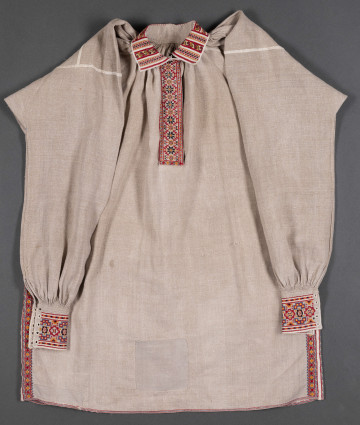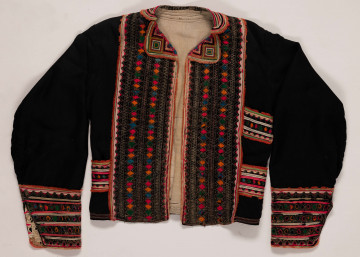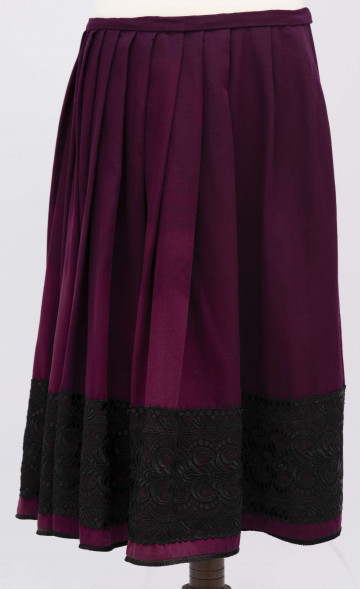
Men’s shirt
1801 — 1900
National Museum in Lublin
Part of the collection: Folk craft of the Lublin Region (19th/20th c.)
A man's dress robe called 'fijarówka' for the outfit from the turn of the 19th and 20th centuries. It was made of self-made cloth woven by a small-town tailor. It was heavy and long, reaching almost to half calf. The cut of the robe, of the oblong poncho type, consisted of a back panel, firmly cut out at the waist with the two fronts sewn together at the shoulders and sides. Both the back and the front panels are cut diagonally from the waist downwards. At the waist on the sides, the seams of front and back panels are sewn together more firmly, creating a protruding fold to emphasise the cut of the robe and the line of hips. The so-called dumb pockets have been left at the sides of the waistband. At the bottom, small wedges are sewn in, two on each side, to give the dress a more trapezoidal shape. The robe is fastened with eighteen hooks from the waist to the neckline. It is decorated with red and dark-blue cordage running down the neckline and along the fastening to the waist in the form of four alternating coloured stripes (red and dark-blue) arranged in the form of loops the ends of which are rolled into snails. On the seams of the folds at the front, side and back, a decorative cord ends in coils. Additionally, on the cords, it has tassels sewn horizontally in the form of bows, called 'chwościki'. A diamond-shaped green cloth is sewn on the cuff, and in the lower part of the dress, narrow bands of the same material are on the sides. Above, there is a cord sash ending in a coil, and tassels at the seams on the folds. On one of the upper left folds, there is also a green strip of material sewn on (perhaps strips were sewn on at the others, but unfortunately, not all the decorations have survived).
The dresses were obligatory for men during weddings and other religious, family, and local rites and events, regardless of the season. The quality of the materials used and the numerous decorations were supposed to indicate the owner's wealth. A dress in this form was worn in the central and southern part of the Lublin region, i.e., it was the attire of the Krzczonów, Lubartowo, Zamość, and Powśle Lubelskie regions.
Author / creator
Dimensions
cały obiekt: height: 107 cm
Object type
sukman
Technique
sewing
Material
cloth, wool
Creation time / dating
Creation / finding place
Owner
The National Museum in Lublin
Identification number
Location / status

1801 — 1900
National Museum in Lublin

1890 — 1910
National Museum in Lublin

1910
National Museum in Lublin
DISCOVER this TOPIC
Museum of King Jan III's Palace at Wilanów
DISCOVER this PATH
Educational path